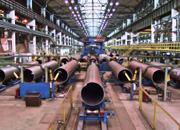How do I control corrosion in stainless steel?
Corrosion in stainless steel is one of the most troublesome technical concerns for fabricators. Whether localized or widespread, corrosion takes many forms, depending on the particular service environment. Some common types are general corrosion, crevice corrosion, intergranular corrosion, pitting corrosion, and stress corrosion, just to mention a few. Regardless of the type, corrosion can become a financial nightmare or, worse yet, result in a catastrophic failure.
Corrosion is defined as an undesirable deterioration of the metal as a result of a chemical or electrochemical reaction caused by the immediate environment. Identifying the source of the corrosion, as well as recognizing the need to prevent it, should be first and foremost.
Control of corrosion in the base metal is the responsibility of the designer. Even with everything done correctly, welds often do not exhibit the same level of corrosion resistance. But if not correct, the corrosion level can be higher. First, choose the correct filler metal. Your welding supplier can advise you on this if the designer has not specified it. For example, the filler metal should meet or exceed the level of molybdenum in the base metal. This could require the use of a nickel-based alloy, especially if the molybdenum content exceeds 4 percent.
Second, the welding procedure must correctly control heat input. This becomes increasingly more critical as the nickel content rises. Excessive heat can cause the formation of undesirable structures and create undue stresses that will only exacerbate corrosion or cause cracking in service. With duplex stainless steels, too much heat or even to little heat can cause undesirable phases to be formed, thus affecting the corrosion resistance.
Be sure to choose the right pre- and postweld cleanup tools for grinding, brushing, and buffing the final weldments. Select stainless steel cleaning tools that have not previously been contaminated from use on carbon or low-alloy steels. Also be sure to remove all traces of slag and welding fume from the base metal. Eliminating any cracks or crevices, such as undercut, is imperative.
Of the many methods to control corrosion, none is better than implementing best practices. Corrosion control is best accomplished by selecting the proper filler metal and following sound fabrication practices. This will ultimately provide maximum corrosion resistance.
 Threeway Steel is known as a professional supplier engaged in manufacturing and distributing a wide range of steel pipe, and our headquarter located the central part of China – Hunan and six associated factories throughout China.
Threeway Steel is known as a professional supplier engaged in manufacturing and distributing a wide range of steel pipe, and our headquarter located the central part of China – Hunan and six associated factories throughout China.
 Threeway Steel is known as a professional supplier engaged in designing, manufacturing and distribution of a wide range of steel products with the headquarter located the central part of China – Hunan and six associated factories throughout China.
Threeway Steel is known as a professional supplier engaged in designing, manufacturing and distribution of a wide range of steel products with the headquarter located the central part of China – Hunan and six associated factories throughout China.
 Threeway Steel is known as a professional supplier engaged in designing, manufacturing and distribution of a wide range of steel products with the headquarter located the central part of China – Hunan and six associated factories throughout China.
Threeway Steel is known as a professional supplier engaged in designing, manufacturing and distribution of a wide range of steel products with the headquarter located the central part of China – Hunan and six associated factories throughout China.
 Threeway Steel is known as a professional supplier engaged in designing, manufacturing and distribution of a wide range of steel products with the headquarter located the central part of China – Hunan and six associated factories throughout China.
Threeway Steel is known as a professional supplier engaged in designing, manufacturing and distribution of a wide range of steel products with the headquarter located the central part of China – Hunan and six associated factories throughout China.
 Threeway Steel is known as a professional supplier engaged in designing, manufacturing and distribution of a wide range of steel products with the headquarter located the central part of China – Hunan and six associated factories throughout China.
Threeway Steel is known as a professional supplier engaged in designing, manufacturing and distribution of a wide range of steel products with the headquarter located the central part of China – Hunan and six associated factories throughout China.

